
MARZO – ACTUALIDAD
¿Quiénes eran? ¿Cómo llegaron a ser lo que fueron?
¿Cómo se definen los contornos de la identidad y sus contenidos? ¿Cómo se registra la transformación de una vida? ¿Qué queda de lo que fuimos? ¿Cómo nos constituyen las miradas de los demás que nos condenan? ¿Cómo nos configuran los que se nos parecen? ¿Es la historia la que nos condiciona o somos quienes hacemos la historia?
Fueron las “locas de la Plaza”, las “madres y familiares de terroristas”, las responsables de una “campaña anti argentina”, las que no habían cuidado a sus hijos. Fueron también las abrazadas por el pueblo, legitimadas oficialmente y reconocidas por distintas generaciones. Hoy vuelven a sufrir el embate de una mirada que intenta ponerlas en el lado oscuro de la historia, son “chorras”, “mentirosas”, tergiversadoras de la historia. Pero ellas son lo que fueron, lo que hicieron de su vida, atravesadas por la violencia pero también por la solidaridad, el amor y la capacidad de hacer con los demás. Cruzaron la frontera y fueron parte de la historia, la mejor de nuestras historias, la de la resistencia, la de la lucha colectiva, la de soñar y trabajar para un mundo más justo.
El mundo camina
¿En qué momento el boceto torpe de un poema se convierte en el último escrito y en documento histórico?
¿Por qué cobra inmensidad un telegrama que sólo dice “llegamos bien”?
¿Qué tipo de belleza recubre el molde de un corpiño trazado a mano, un tablero con números del sorteo de una camisola de jean bordado, o libros de viaje con anotaciones de ideas, gastos, itinerarios, preguntas?
¿Qué instantes de dolor, de lucha, de alegría quedaron atrapados en esas fotos caseras?
Podemos contarlas está integrada por archivos de mujeres atravesadas por la desaparición de un familiar durante la última dictadura militar. Mujeres que dejaron en suspenso parte de su vida para transformarse en otras.
Mujeres que eran estudiantes, trabajadoras, profesionales, amas de casa, madres, hermanas, compañeras, abuelas, niñas, costureras, cocineras, creyentes, agnósticas, dibujantes, actrices, militantes. Y también fueron viajeras, escribientes, comunicadoras, detectives, caminantes. Se organizaron y transformaron su reclamo individual en una lucha colectiva.
En el camino del reclamo fueron atesorando cartas, escritos, fotos, afiches, volantes y notas periodísticas que dan cuenta de la búsqueda personal pero también de sus vidas pasadas y de sus acciones posteriores a la desaparición. Los documentos nos dicen acerca de los modos de mirar, de contarse, de indagar, de callar, de ocultar, de gritar, de amar.
¿Qué guardaron y para quién? ¿Qué objetos y documentos narran la existencia del trauma? ¿Qué dimensiones políticas habitan lo doméstico? ¿Cómo lo privado tiñe lo público?
Estos archivos personales muestran la minuciosidad con la que guardaron copias de las cartas enviadas, las respuestas siempre insuficientes, las presentaciones judiciales, las anotaciones en trozos de papel, los reclamos a la dictadura primero y a los gobiernos democráticos después. Desde el grito desesperado, dónde están y aparición con vida, hasta la búsqueda persistente de verdad, justicia y memoria.
Podemos contarlas exhibe documentos de los archivos personales de:
Nora Morales de Cortiñas (hijo: Gustavo Cortiñas, desaparecido el 15/04/1977).
Mabel Penette de Gutiérrez (hijo: Alejandro Gutiérrez, desaparecido el 24/07/1978).
Rosa Tarlovsky de Roisinblit (hija: Patricia Roisinblit, desaparecida el 8/10/1978 y su nieto nacido en cautiverio, Guillermo Rodolfo Fernando Pérez Roisinblit, y recuperado en 2004).
Isabel “Chicha” Chorobik de Mariani (nieta: Clara Anahí Mariani, desaparecida el 24/11/1976)
Matilde “Sacha” Artes Company (hija: Graciela desaparecida el 2/4/1976 junto a su hija Carla Rutila Artés, restituida en 1985).
Olga Martegani de García (hijo: Alejandro García, desaparecido el 16/3/1977).
Mercedes Lagrava de Martínez, (hijo: Atilio Martínez Lagrava, desaparecido el 21/6/1977).
María Isabel Cattáneo de González (hermano: Atilio Jorge Cattáneo, desaparecido el 4/01/1977).
Adelina Dematti de Alaye (hijo: Carlos Esteban Alaye, desaparecido el 5/5/1977).
MARCH – CURRENTLY
Who were they? How did they become what they were? How are the contours of identity and its contents defined? How is the transformation of a life recorded? What remains of what we were? How do the gazes of others who condemn us constitute us? How do those who look like us shape us? Does history condition us, or are we the ones who make history?
They were the “crazy women of the plaza,” the “mothers and relatives of terrorists,” those responsible for an “Anti-Argentine” campaign, those who had failed to care for their children. They were also embraced by the people, officially legitimized and recognized by different generations. Today they once again suffer the onslaught of a gaze that attempts to cast them on the dark side of history; they are “thieves,” “liars,” distorters of history. But they are what they were, what they made of their lives, marked by violence, but also by solidarity, love, and the ability to do good for others. They crossed the border and became part of history, the best of our stories, one of resistance, of collective struggle, of dreaming and working for a more just world.
The World Moves On
At what point does the clumsy outline of a poem become “the last piece of writing” and a historical document? Why does a telegram that only says “we arrived safely” take on immensity? What kind of beauty cloaks the pattern of a hand-drawn bra, or a board with numbers from a lottery for an embroidered denim camisole, or travel books with notes of ideas, expenses, itineraries, questions? What moments of pain, struggle, and joy were captured in those homemade photos?
The exhibit is made up of archives of women affected by the disappearance of a family member during the last military dictatorship. Women who put part of their lives and their daily lives on hold to transform themselves into others. Women who were students, workers, mothers, sisters, companions, grandmothers, seamstresses, cooks, children, believers, agnostics, cartoonists, actresses, activists. And they were also travelers, writers, communicators, detectives, walkers. They organized and transformed their individual demands into a collective struggle.
Along the path of their demands, they collected letters, writings, photos, posters, flyers, and newspaper articles that recount their personal search, but also their past lives and their actions after their disappearances. The documents tell us about their ways of seeing, of telling stories, of investigating, of keeping silent, of hiding, of shouting, of loving…
What did they keep and for whom? What objects and documents narrate the existence of trauma? What political dimensions inhabit the domestic sphere? How does the private color the public?
Their personal archives show the meticulousness with which they kept copies of the letters they sent, the always insufficient replies, the court filings, the notes on scraps of paper, the demands first to the dictatorship and then to the democratic governments. From the desperate cry of where they are and their return alive to the persistent search for truth, justice, and memory.
Before and After the Absence displays documents from the personal archives of:
Nora Morales de Cortiñas (mother of Gustavo Cortiñas, disappeared on April 15, 1977).
Mabel Penette de Gutiérrez (mother of Alejandro Gutiérrez, disappeared on July 24, 1978).
Rosa Tarlovsky de Roisinblit (mother of Patricia Roisinblit, disappeared on October 8, 1978), and grandmother of Guillermo Rodolfo Fernando Pérez Roisinblit, born in captivity and recovered in 2004).
Isabel “Chicha” Chorobik de Mariani (grandmother of Clara Anahí Mariani, disappeared on November 24, 1976)
Matilde “Sacha” Artes Company (mother of Graciela, disappeared on April 2, 1976, along with her daughter Carla Rutila Artés, returned to her in 1985).
Olga Martegani de García (mother of Alejandro García, disappeared on March 16, 1977).
Mercedes Lagrava de Martínez (mother of Atilio Martínez Lagrava, disappeared on June 21, 1977).
María Isabel Cattáneo de González (sister of Atilio Jorge, disappeared on January 4, 1977).
Adelina Dematti de Alaye (mother of Carlos Esteban Alaye, disappeared on May 5, 1977).



